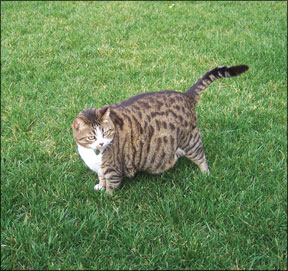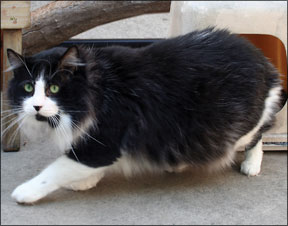For the first several years of her life, your cat Tina was slim, agile and remarkably athletic. In the past year or so, however, Tina, formerly light on her feet, has become heavy in her body. You can 288 no longer see or feel her ribs. She seems to have accumulated a pad of fat over her spine, and it even appears that shes developing quite a potbelly. Her behavior has changed as well. Forget about climbing trees and chasing chipmunks. For the past few months, Tina has seemed to be quite content living the life of a couch potato, dozing frequently and showing little interest in activities other than eating, drinking and climbing into and out of her litter box an activity that, due to her increasing corpulence, is becoming quite a chore for her. None of these physical and behavioral changes should be regarded lightly. Indeed, they should all be taken very seriously, with veterinary consultation definitely in order. The presence of the potbelly in itself is enough to cause alarm, since a distended abdomen may signal the presence of accumulated blood or body fluid, an enlarged kidney, liver or spleen, or the development of a lethal tumor. Its more likely, however, that Tina is simply too fat for her own good, and thats not to be taken lightly either, since feline obesity is strongly associated with several disease conditions that can seriously diminish a cats quality of life and perhaps lead to an unexpected and premature death. A Common Problem Is Tinas weight problem unusual? Not in the least, says Francis Kallfelz, DVM, a professor of veterinary nutrition at Cornell Universitys College of Veterinary Medicine, who says, “There is no question that feline obesity is the number-one nutrition-related disorder in cats today.” It is estimated, he notes, that 40 percent of all cats in the U.S. are either overweight or obese. To assess the weight status of a cat, he explains, veterinarians often use a nine-point scoring system, with scores of 4.5 to 5 points indicating that an animal is at its ideal weight. A score of 9 would mean that a cat is grossly obese, while an emaciated, severely underweight cat would have a score of 1. “Any cat that has a score above 6.5 or 7,” he says, “would be classified as seriously overweight, and a score of 8 or above would definitely mean that its obese.” Revealing Signs In most cases, he notes, you dont need this scale in order to determine that your cat is overweight. “You can tell by simply looking at the animal,” says Dr. Kallfelz. “When you look at a cat of normal weight from above or from the side, youll see a narrowing, or tuck, behind its rib cage. When that tuck disappears and the cat seems to be developing a pot belly, thats an indication that it is overweight or obese.” Other clear indications of obesity, he adds, include the accumulation of fat over the hips and rear end, and a reluctance to engage in strenuous activity. At the same time, he points out that a number of physical conditions may make a cat appear to be obese although it is not. A pregnant cat, for example, is likely to appear overweight when she really isnt, considering her condition. An animal with a serious liver disease may develop an excessive accumulation of fluid in its abdomen that will make it appear fat. Likewise, a cat with cancer in its abdomen may develop an accumulation of blood or other liquid in its abdomen that makes it look fat and may exhibit lethargy, two typical signs of obesity. A Delicate Balance The chief cause of feline obesity, says Dr. Kallfelz, involves “simply an equation of caloric intake versus caloric expenditure. There should be a direct balance of intake and expenditure in this regard. When a cat consumes more than it expends, it will, of 288 course, gain weight.” A diet that is high in carbohydrates is especially likely to cause weight gain, he notes, since cats are naturally equipped to eat and digest prey that is constituted mostly of water, protein and fat, but not much carbohydrate. “So, just like humans,” he says, “a cat that consumes a diet that is overly rich in carbohydrates will store them as fat.” In addition to inhibiting a cats normal penchant for physical activity, seriously compromising its quality of life and probably shortening its life span, obesity can exacerbate several disorders. Among the conditions often aggravated by being overweight is osteoarthritis, a frequently observed condition characterized in part by the erosion of cartilage, the smooth tissue in joints that protects the ends of bones from painfully rubbing directly against one another. Another joint condition that is exacerbated by obesity is hip dysplasia, a genetically inherited and incurable malformation in which the femoral head of a cats thigh bone does not fit properly into the socket at the lower end of the animals hip bone. The most effective therapeutic approach to treating hip dysplasia is a weight control program that starts early in an affected cats life, the purpose of which is to take as much pressure as possible off the animals limbs. Feline obesity is also strongly associated with diabetes mellitus, a disease caused by insufficient production of or response to the hormone insulin, which is essential to the regulation of blood sugar. In addition, obesity has been linked to hepatic lipidosis, a very serious and potentially lethal liver disease. Cardiovascular health can also be impaired by obesity, he notes. “Certainly,” he says, “an extra burden is placed on a cats heart and vascular system when they have to move blood through all of this excess tissue.” The Right Stuff Given these risks, says Dr. Kallfelz, it stands to reason that a cats life span may be substantially extended and its quality of life significantly improved if its owner carefully manages and appropriately restricts the animals caloric intake. However, he advises, a weight-loss program should not be undertaken without the consultation of a veterinarian, since many signs of obesity may be caused by physical abnormalities or diseases that require specific treatment. If no underlying disease is discovered, the veterinarian is likely to recommend a weight-reduction program comprising two elements: a decrease in the cats daily caloric intake and an at-home exercise program geared to help the animal burn more calories each day than it consumes. Regarding the feline diet in general, Dr. Kallfelz offers the following advice: “Make sure youre feeding a food thats guaranteed to be complete and balanced for the life stage of your cat, and make sure youre feeding your animal the proper amount. You can find a nutritional guarantee on the label of virtually every cat food on the market today. And make sure that you dont overfeed the animal. Watch its weight. An adult cat at maintenance weight should be neither losing nor gaining. As long as the label carries the appropriate life-stage guarantee and is a properly formulated diet, it shouldnt make any difference whether its wet or dry food.” 




